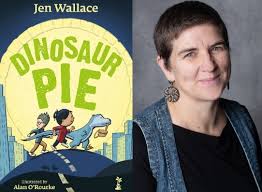A slice of (Dino) pie anyone?
- armadilloeditor
- Aug 17, 2024
- 4 min read
When you first feel that you wanted to write stories featuring neurodivergent characters and why ~ if there was a moment like that!
There wasn't actually a moment, the characters kind of came of their own accord. For example, as I explored Rory's personality it became obvious he had ADHD. Neurodivergence is my lens and experience, so it's my normal. When I'm writing characters, they usually just turn out to be neurodivergent, even though it might not be explicit. It took me a while to realise that this was important, that neurodivergent voices creating representation is a very important thing in the book world.
Dinosaur Pie had me laughing out loud at the silliness ~ not at the characters but the situations. It is not an easy balance to create, to give young readers that freedom, what techniques do you use?
I am so glad you enjoyed it and appreciated the humour.
I try to write with kindness and this may sound odd but I try to be considerate of my characters and speak about them respectfully, as I would when talking about any child. I suppose I laugh at myself a lot and the ridiculous situations I find myself in, and this is reflected in my work. I think humour is a very Irish tool for dealing with adversity.
I have to ask, as a mother, have you ever found yourself telling the children they are eating dinosaur, then discovered them being dinosaurs, or any other creature or was this imagined entirely for the book?
The whole concept of dinosaur pie came about because I was trying to get two uninterested toddlers to eat their dinner, and so told them it was Dinosaur Pie. It worked! The questions they asked led to me writing a poem about dinosaur pie which eventually became this book.
To this day we regularly eat dinosaur pie. No transformations to report yet and just the occasional Graagh!
The story is funny, it is also pacey without being too fast for independent readers. How do you manage to keep a good pace without losing your reader?
I use Rory's voice and imagine him as a kid who explains enthusiastically and talks quickly, so he keeps us all moving along with his chatter.
I am a big fan of short chapters that end with a cliff-hanger to keep everyone wanting just one more chapter.
Are any of the characters based on people you have met? The teachers and supermarket store manager come to mind…!
No character is directly based on anyone I know, they are a mishmash of traits I have seen in people. As I write characters they seem to develop complex personalities all of their own. Sometimes, it’s more like I am discovering them than creating them.
There is, of course, a bit of me in all the characters, and I'm slightly distracted and chaotic like Rory's mum. My children would argue that the kids in the book are nothing like them and they would kill me if they thought I was writing about them.
Lex is a fantastic character, a Goth. I imagine many children will never have met a Goth, but he is also a teen, not batting an eyelid at the change in Rory. Why did you choose this character and did you feel it was important to have an older child who was as understanding as Rory’s friends?
I’m so glad you liked Lex, I really enjoyed writing him. I think teenagers get a lot of bad press, and I loved the idea of representing a supportive caring relationship between Lex and Rory. Their relationship was one of the first I developed, even before Oleg and Daria.
I love asking readers to look beyond appearances and hope Lex challenges a few preconceptions.
I was intrigued by the storyline that finds Rory unable to look at a screen for too long as it is making him feel too unwell. Did you include this as it is a typical response for neurodivergent people or to encourage children to realise screen time isn’t healthy?
This actually came from my research into dinosaur eyesight (I get to do some really fun research). I realised birds, and dinosaurs would process things very differently to humans and so tried to capture that.
There is no intended message there about screens at all. In fact, for many neurodivergent folk playing computer games is an enjoyable way for them to destress and regulate.
Every chapter has a heading, a description, rather than a number, was this important to you, to make this part of the story?
I had great fun writing the chapter titles (especially those at the end). It's something I really like that is used in children's shows and graphic novels (and poetry too), and as you say it draws the reader in.
The book is illustrated throughout. Was this your choice or the publishers? How do you think illustrated books help young readers? What are the benefits of the illustration?
Little Island, the publishers, wanted to make it highly illustrated and I was delighted with that. Alan O'Rourke did a great job. I think the illustrations compliment the pace and bring a whole other layer of interest for young readers. Text without illustrations can be very overwhelming for some readers and I love the way the book has been laid out to be so accessible to lots of different types of readers.
Dinosaur Pie is your debut. Can we expect more? Are you working on any projects at the moment you could share a sneak peek of with our readers?
I am actually working on three different books right now (thank you ADHD brain) They are at varying stages and I flit between the three. One of them has a real Scooby Doo vibe and I’m enjoying writing funny-scary.
Dinosaur Pie is published by Little Island Books and available from all good bookshops.

.jpg)










































Comments